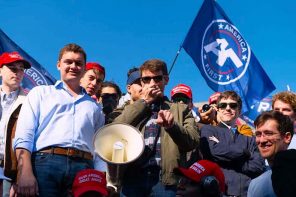Why David Sometimes Wins: Leadership, Organization and Strategy in the California Farm Worker Movement
By Marshall Ganz
Oxford University Press, 2009
Marshall Ganz is an organizer, a teacher, a scholar, and a Jew. And not necessarily in that order. His personal story, as he is the first to explain, is integral to how he came to be the top organizer for the United Farm Workers in the heyday of Cesar Chavez; he later became a scholar and teacher of organizing at Harvard, and, most recently, a strategist in the improbable presidential campaign of Barack Obama.
His long-awaited book, Why David Sometimes Wins: Leadership, Organization and Strategy in the California Farm Worker Movement, is a very readable analysis of exactly how powerless Mexican Americans, led by the legendary Cesar Chavez, overcame impossible odds to form the United Farm Workers union while capturing the heart and the imagination of the nation.
But Ganz wants to do much more than to retell a familiar story; he seeks to find in this analysis lessons that transcend our moment, lessons that are as old as the story of David and Goliath. In doing so, he has identified strategic principles that are more culturally relevant and accessible than those the ever-popular ancient Chinese military strategist, Sun Tzu. This alone makes the book a must-read for anyone, religious or non-religious, who is involved in the politics of social justice.
But there is a shocking conclusion to this book that is not for the nostalgic or the politically fainthearted. “David can sometimes win, and a heroic story it can be,” Ganz ruefully observes, but “it can also become a tragedy.” And while the book teaches us valuable lessons about what’s needed to take on the rich and powerful (what Ganz calls “strategic capacity”), what went wrong at the height of the UFW’s success holds lessons, Ganz warns, that analysts and organizers of social movements can not afford to ignore.
Mississippi Eyes
I first met Marshall Ganz at one of the founding meetings of Progressive Democrats of Massachusetts, an outgrowth of the remarkable 2002 Democratic primary campaign of former Labor Secretary Robert Reich for governor. Reich came in a respectable second while revitalizing the progressive wing of the Party. A lot of electoral neophytes like me learned, among many valuable lessons, the mechanics of electoral politics. After the election, many of us agreed that we should continue to organize to build our capacity to help candidates who were up against entrenched interests.
What could we do that would help to persuade good candidates to get in, and to prevail against the odds? The answer, we realized, was us. We would create a statewide network of volunteer electoral activists of the sort that can be a decisive factor, particularly in party primaries. Four years later, we played an important role in getting the then almost unknown African American attorney Deval Patrick elected Governor of Massachusetts. Much of what we were able to contribute was thanks the principles of organizing we learned from Marshall Ganz.
Marshall was one of the first people I asked to contribute to what became the 2008 anthology, Dispatches from the Religious Left: The Future of Faith and Politics in America. His opening essay explains how he found answers to the questions posted by the ancient Rabbi Hillel, who famously asked, “If I am not for myself, who will be for me? When I am for myself alone, what am I? If not now, when?” He writes, “And only as I began to look for words to teach this craft—developing leadership, building community, and taking public action—did I really hear the questions Hillel asked 2000 years ago.” Why David Sometimes Wins brings us the words he had found to teach the craft of organizing.
It took a while, he explains in his introduction, to understand that the biblical story of Exodus is not merely the story of Moses leading his people out of slavery in Egypt. “I came to see this as a journey that passes from generation to generation.” For Ganz, the story of Moses and the story of David and Goliath are not merely ancient tales of God’s champions, but the story of how we live: metaphorical maps of who we are, who we might become, and how we might get there.
Ganz’s father was a rabbi, and a military chaplain during WWII; many survivors of Nazi genocide passed through his home. “Although I was too young to grasp the full horror of what had occurred,” Ganz writes, “the people whom I’d met had clearly survived a catastrophe.” His parents taught him that the Holocaust was not just about anti-Semitism, but about racism. It was this view that led him to drop out of Harvard to join the Civil Rights movement in Mississippi in 1964; and when he returned to his native Bakersfield, California, in 1965 to see for the first time, the plight of Mexican-American farm workers through “Mississippi eyes.” He soon got involved with the farm workers’ movement and over the next 16 years served in a variety of positions, including organizing director and as a member of the board (1973-1981).
Getting Out of Egypt
Why David Sometime Wins opens with an eye-opening history of largely unsuccessful farm worker organizing from the mid-19th century. Ganz explains how the exploitation of migrant, immigrant labor and people of color who happened to be citizens, has been integral to the business model of California agribusiness from the beginning; starting with unemployed Chinese railroad workers in the 19th century, and, eventually, Filipino, Japanese, and Mexicans hired by growers to work in the fields. When an influx of white refugees from the dust bowl were immortalized in John Steinbeck’s The Grapes of Wrath, the plight of the farm workers came briefly to national attention. It did not last, but the story continued to threaten powerful interests such that Ganz reports that the book was banned from Bakersfield libraries when he was a child. (More recently, it is worth noting, religious right leaders in Texas have sought to ban any mention of Cesar Chavez from public school textbooks.)
Much of Ganz’s book focuses on how three unions (the Teamsters, an organizing committee of the AFL-CIO, and the group that became the UFW) competed, beginning in the 1960s; and why the UFW prevailed over these more powerful, better financed, and politically connected entities.
The main reason, he explains, is that:
the UFW’s leadership devised more effective strategy, in fact a stream of effective strategy. The UFW was able to do this because the motivation of its leaders was greater than that of their rivals; they had better access to salient knowledge; and their deliberations became venues for learning. These are the three elements of what I call strategic capacity—the ability to devise good strategy. While I do not claim that strategic capacity guarantees success, I do argue that it makes success more probable.
He goes on to describe how strategic capacity allows an organization to take best advantage of unique opportunities as they present themselves.
Examples abound throughout the book, as the UFW leadership team gathers to figure out how to adjust in light of new favorable circumstances or a seemingly devastating move by the growers or union rivals. Ganz adds that strategic capacity is not merely about making plans; it is “a function of who leaders are—their identities, networks and tactical experiences—and how they structure their interactions with each other and their environment with respect to resource flows, accountability and deliberation.”
A few illustrations:
The UFW was primarily led by people directly involved in the community being organized—they brought younger Mexican Americans into leadership; people with complementary skills, social networks, and life experiences. This stood in contrast to their Big Labor competitor which, although well-funded, tended to be controlled by turf-conscious, older Anglos who came out of industrial union organizing, had no knowledge of or experience in California farm issues, and not only did not speak Spanish but had few contacts in the Mexican American community. At least as significantly, the Big Labor efforts were tightly controlled by senior officials, whereas the UFW’s leadership and strategy making leadership was broader, far more flexible, and premised on considerable delegation of authority. It was a cause: La Causa. For the Big Labor leaders, it was primarily a job.
The religious and cultural context was at least as important as the racial element of ethnicity. During key organizing campaigns, for example, daily Catholic mass was as integral to the campaign as Catholicism was integral to the identity of the Mexican American farm workers, and the community from which they came.
The UFW, in the heat of the 1960s, cast itself as much as a civil rights struggle as it did a labor struggle. They learned from the example of the African American civil rights struggle, and drew on the reinvigoration of the Catholic social justice tradition stemming from Vatican II, as well as an interfaith cast of religious leaders and institutions across the country (notably, the National Council of Churches and the US Conference of Catholic Bishops). Competing union organizers sneered at this. One declared, characteristically: “This is a trade union dispute, not a civil rights movement or a religious crusade.”
Each step of the way, religious people and institutions (and related social networks) played pivotal roles. For example, a progressive labor priest, Fr. Thomas McCullough, first identified a young parishioner, Cesar Chavez, as having “potential.” A young Union Theological Seminary graduate, Rev. Jim Drake, served as Chavez’s driver in the early days; and likewise Chris Hartmire stepped up as a young director of the Catholic Church’s “Migrant Ministry.” Both became part of the UFW’s predecessor group’s “strategic planning.” Examples like these abound.
The Farm Worker Association’s founding convention was held in a Catholic Church in Chavez’s hometown of Delano, California, and the preamble to their constitution included a quote from Pope Leo XIII’s Rerum Novarum—a papal encyclical written in response to the ravages of late-19th century industrial capitalism:
Rich men and masters should remember this—that to exercise pressure for the sake of gain upon the indigent and the destitute, and to make one’s profit out of the need of another, is condemned by all laws, human and divine. To defraud anyone for wages that are his due is a crime which cries to the avenging anger of heaven.
The Game that Ended the Union
Most of the book is an encouraging, tightly argued narrative that shows us how the UFW overcame obstacles, and gathered a strategic capacity and the power to compel growers to recognize the union and to negotiate fair contracts. But Ganz quickly dispatches the reasons other scholars and commentators have offered for why the UFW began to unravel at the height of its success in the late ’70s. Ganz knows because he was a member of Chavez’s inner circle or “leadership team” during the period Chavez was coming under the influence of Charles Dederich, founder of Synanon (“a Los Angeles-based drug treatment program that had evolved into a cult and had declared itself a ‘religion’ a few years earlier”).
Chavez compelled his top leaders and organizers to participate in Synanon’s fiercely confrontational encounter group technique he called “the game.” Ganz describes it as “an intensely political kind of group therapy. In emotionally aggressive sessions with 10-15 persons, participants verbally attacked each other to air problems” for periods of one to three hours.
Ganz concludes, “Chavez transformed UFW deliberations into a controlled, exclusive and judgmental process in which one’s loyalty was constantly on the line.” Chavez sought to make “the game” as central to the practice of the union as it was to Synanon. In the Spring of 1978, Chavez required 200 staffers to travel as much as five hours to attend weekly sessions.
The UFW degenerated into a “community of unpaid cadres, loyal to a single leader, governed by groupthink rituals, and enjoying the apparent efficiency of unquestioning obedience.” Ganz continues, “It’s unclear how Chavez hoped to reconcile Dederich’s vision with that of a democratically accountable union organized to represent workers—especially when the UFW thrived on diversity, contentiousness and creativity. In fact, he could not.”
In a sustained frenzy of political paranoia, Chavez fired or drove out the committed veterans who had brought the UFW so far. Control became concentrated in the hands of Chavez family members and dependents.
In short, Chavez “scrapped the strategic capacity that the UFW had taken years to develop,” and the UFW stopped organizing and “moved into the kind of advocacy, services provision and public policy work that other nonprofits had done for years.” Even after Chavez’s death in 1993, the UFW never regained its capacity for organizing. At its height, the UFW had 70,000 workers under contract; today that number is no more than 5,000 and the UFW serves mostly as a hub of a network of nonprofit agencies.
Ganz does not explain why Chavez came unglued or how Dederich came into his life and was able to wield such influence in the union. But in telling the truth about the matter, Ganz plants a red flag on the problem for those who come later. This is important in part because what happened with the UFW in many ways epitomizes what we saw in the 1970s, when many religious, political, business, and psychotherapy cults employing similar techniques wreaked havoc in the culture. Some of this continues to this day, including programs modeled on Synanon, and it remains a dark social and political undercurrent that most of us choose not to see, let alone address.
The UFW story points to vulnerabilities in open, democratic organizations, religious or non-religious, whose spirit of openness can blind them to abuses by anti-democratic elements. This can be compounded by the mutual deference that allow people to turn a blind eye to leaders and members who are turning healthy institutions into monsters.
Ganz has a few suggestions on the importance of ensuring the viability of democratic structures of leadership development so that challengers have an avenue to challenge leadership in a responsible manner. This becomes especially important when a leader is not only failing but consolidating power as in the case of the UFW. But clearly, there are no easy answers.
Even as David sometimes wins, Ganz poignantly observes, “remaining David can be even more challenging than becoming David in the first place.”




